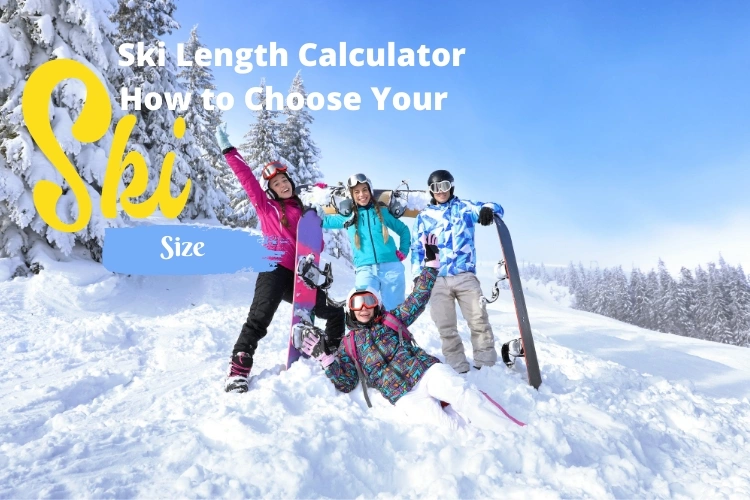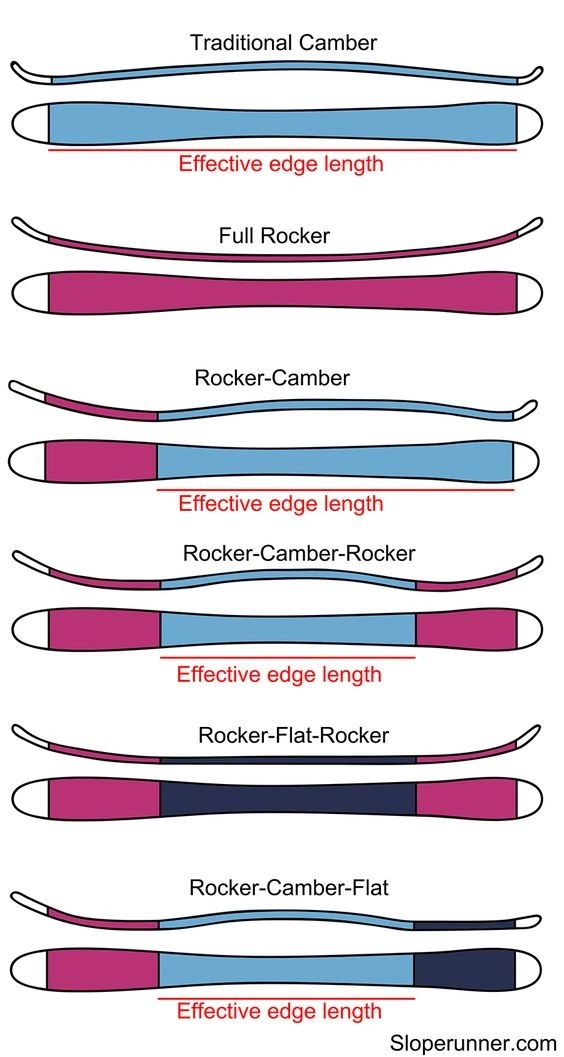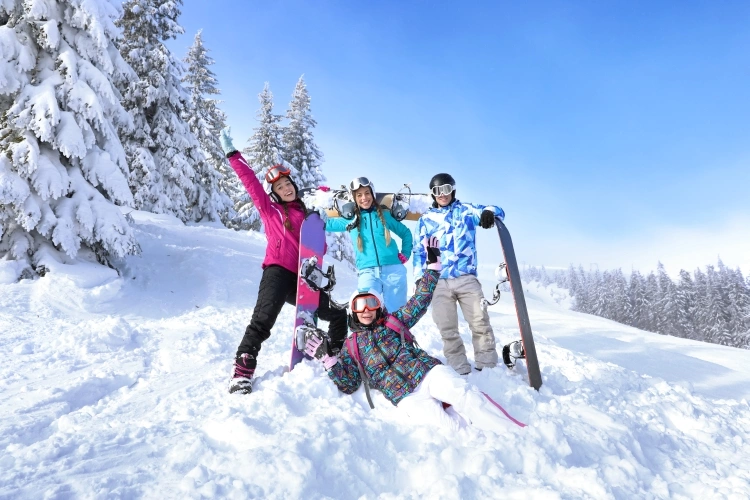Ski Length Calculator - How to Choose Your Ski Size?
by Frank V. Persall
Planning to buy or rent a pair of skis but not quite sure how to get the right ski for you? Don't worry, we got you covered!
Buying a ski can be a daunting task since there is a large variety of skis on the market. One increasingly popular way for skiers use to choose the right ski size is by using an online ski length calculator.
An Online Ski Length calculator is a tool that lets you input some information with which it can calculate the best skis size for you.
Contents
However, determining the right ski size for you isn't only about plugging in the necessary values. Other factors also influence your decision. For instance, some skis are best used on powder terrain/slopes while others are suitable for mountain courses.

That said, the general rule for everyone buying their skis, especially as a casual skier, is that your skis must measure somewhere between your chin and the top of your head. Expert and professional skiers on the other hand tend to choose skis that are slightly above their head due to their high-speed style of skiing.
How is Ski Length Calculated?
As you can see from the ski length calculator above, you are required to enter some personal information; mainly your height (both in feet and inches). You are also required to state your skill level as a skier.
These two factors will then be used to calculate the most effective ski length for you. Typically, the shorter you are, the shorter your ski would be compared to standard ski dimensions. For example, a skier that is 6 inches tall will have to use skis that are between 170 and 190 cm.
Your skill level as a skier also plays a role since it gives more insight into your style and skiing preference. For instance, as a beginner, if you enroll in a training class at a resort, you will be given long a pair of standard skis. However, as you become more proficient and confident in skiing, your speed starts to increase.
When To Increase or Decrease Your Ski Length

There are several reasons why you might have to decrease or increase the length of your ski even after using an online ski length calculator. Typically, when using short skis, you can expect your turns to be smoother and easier compared to when you use longer skis. However, the longer skis tend to offer incredible stability at high speeds which is something shorter skis are not known for.
There are also rockered skis that come with rockers at their tip and tail. Their unique property is that they pivot easier and fluid while making various maneuvers. Such skis are usually longer than camber skis.
That said, here are highlighted reasons to help you decide when to increase or decrease your ski length:
When to decrease ski size:-
- If you are a beginner skier
- If you weigh less than the expected average weight for people in your height group
- If you prefer short and quick turns and also do not prefer skiing fast
- If you do not want rocker attachment on your ski
When to increase ski size:-
- If you prefer fast and aggressive skiing
- If you weigh more than the expected average for your height group
- If you plan to ski on bumpy terrain or off-trail slopes
- If you want skis with a rocker attachment
NOTE: While following this rule, remember that most ski brands have their unique scale for measuring the length of skis. This means there will always be discrepancies in dimensions from brand to brand.
Factors That Affect Overall Ski Performance
Several factors might make your experience using the newly purchased skis not as smooth as you would like. As a result, we will discuss the key factors while also highlighting how they affect ski performance.
1. Ability Level
Your ability level simply refers to how skilled you are when it comes to skiing. There is only three ability level a skier can attain: Beginner, Intermediate, and Advanced or professional. Here is a summary of each skill level and the characteristics you should look out for:
a. Beginners
You fall in this category if you only just started skiing. Someone who knows how to ski but rarely does it also falls into this category. Some important properties your ski must-have includes
- Soft flex
- Narrow width
- Composite design
- Foam or wood (softwood) core
- Capped constructions
So not only do you have to find the right length, but you also need to be sure the model you are buying has all of the aforementioned features.
NOTE: Capped construction as mentioned above includes having a rocker at the tip and tail. This makes the ski smoother at the head and tail which improves turning ease.
b. Intermediate/Advanced
This is perhaps the largest category since most skiers have basic knowledge of skiing and have skied enough time to gain experience. Skiers in this range usually prefer powder slopes.
If you are in this category when buying your ski, some of the properties or features to watch out for include a strong wooden core, larger width. They also usually feature sandwich sidewall construction.
Depending on the model, you will also find a camber or rocker or a combination of the two attachments. Such skis are suitable for high-speed skiing and are sometimes used by professional skiers.
NOTE: This type of skis mostly come in long sizes.
c. Professional/Expert
The last ability level is the professional/expert category. Skiers in this category are very skilled and aggressive. They do not have a specific terrain they prefer to ski on and would often perform highly skilled maneuvers in demanding weather conditions.
Skis for this category of skiers often come with a layer of titanal, flax, or other materials that can improve performance, especially at top speed.
The skis also often come with different types of rocker configurations depending on the style of skiing the skis are designed for.
2. Ski Waist width
Another factor that influences the overall performance and feel of your skis is their waist width. It is one property of skis that often tends to be overlooked by beginner skiers.
The waist width refers to the measurement of the width of a ski at its middle or narrowest point.
Waist width largely influences how the feels when you turn. However, the waist width also determines how well the ski will perform on powder snow.
Skis with a narrow waist width are very great for making quick and sharp turns. Skis with wider waist width offer better flotation and speed in powder or choppy snow.
3. Rocker and Camber
Camber is the term used to describe the slight upward curve seen in the middle of skis with the point where the ski makes contact with the snow or ground. Skis with camber require you to be more precise while initiating runs and they offer superb power and response on groomed or hard snow. This is why it is often preferred by highly skilled skiers
Rocker is simply a camber ski turned upside down. This is why it is sometimes referred to as reverse-camber.
All skis are either rockered, cambered, or a combination of the two. Cambered skis generate more pressure on the snow and often come with a flex that improves performance. Rockered Skis on the other hand offer superior float but only perform well on soft snow.
Wide skis are usually designed with rockers hence why they are often only suitable for powder snow. This type of skis also has increased ease of turning with a significantly reduced chance of tipping.
NOTE: There are also flat skis which is essentially another variation of rockered skis. They provide better performance on hard snow and still retain the increased ease of turning and float that rockers provide. They are optimal for beginner and intermediate skiers.
4. Terrain
One of the reasons why there are different types of skis is that they are designed to be suitable for a particular type of terrain. Each terrain requires different styles of skis. For instance, there are all-mountain skis, powder skis, etc.
Conclusion

In summary, while there are different ways to identify the ideal ski length for you, using the information our online ski length calculator is quite fast and efficient. One good tip to keep in mind after obtaining information from the calculator is to check out ski stores or shops and try out different models that match the right length.
There are many online ski stores or shops that let you compare more than one ski in terms of pricing, design, style, and attachments. Some of these online stores offer buyers the chance to buy and return skis from the same model if the length is not quite right. With that in mind, we recommend you follow some if not all of the different suggested criteria to get the right ski length for you. This is because while the ski length calculator will give you a theoretical and precise figure of the ideal length of the ski to buy for your height and weight, some other factors influence the overall performance of skis.
 |
 |
 |
 |

About Frank V. Persall
Frank is originally from the UK, but he has a passion for skiing that knows no bounds. He has made it his life's mission to visit the best ski resorts across the USA and the World. Frank loves spending time with his wife and three children on ski slopes, as they all share his love for the activity.
Thoughts on "Ski Length Calculator - How to Choose Your Ski Size?"
 |
 |
 |
 |
You can get FREE Gifts. Or latest free skiing books here.
Disable Ad block to reveal all the info. Once done, hit a button below
 |
 |
 |
 |